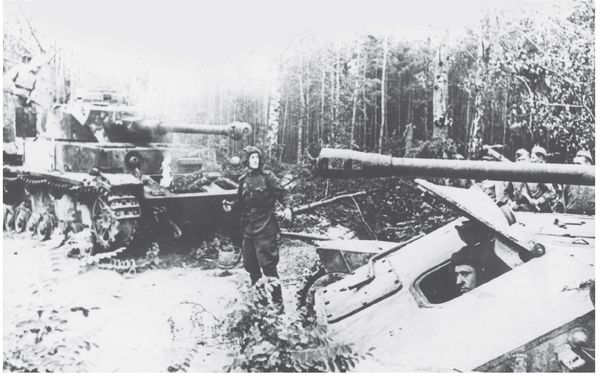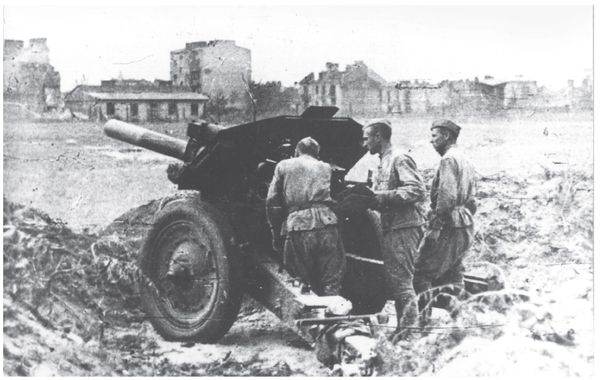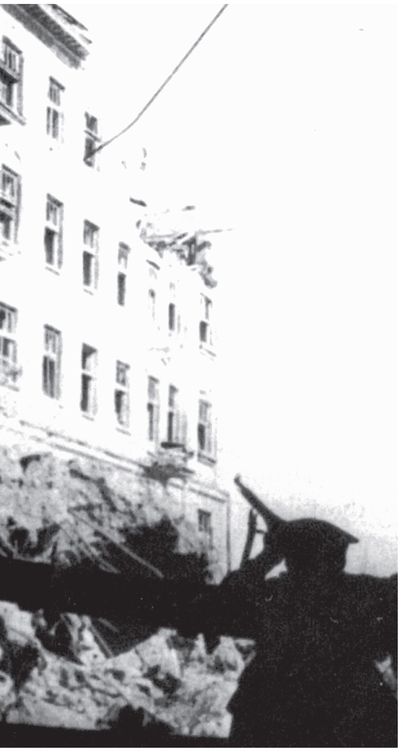Authors: Norbert Bacyk
Warszawa II (22 page)


An Sd Kfz 251/7 ausf D with its crew from the 19th Panzer-Division near Warsaw in September 1944. The Sd Kfz 251/7 was one of the two pioneer variations of the 251. (Leandoer & Ekholm archive)
Soviet tank troops examine the wreck of a destroyed tank, model PzKpfw IV Ausf. H, probably from Panzer-Regiment 27, 19th Panzer-Division, MiÄdzylesie, September 1944. (WAF)

General Rola-Żymierski, well-aware of how many soldiers from the Home Army were now serving in the 1st Polish Volunteer Army, was forced to weigh his words carefully when he formulated this order. For this reason he added the following:
“Among Warsaw's ruins and on its barricades fight the cream of the Polish people's fighting spirit â Here, struggle heroic officers, non-commissioned officers and soldiers of the Polish resistance movement. Fighting with a degree of effort never before witnessed, they are making a great sacrifice in lives and blood in the struggle for our capital city. They are an inseparable part of the Polish Army.”
At the same time, following the regrouping and consolidation of the artillery, the 47th Army together with the 70th Army resumed their collective assault in the direction of Legionowo, at 1500 hours on September 16. But on this occasion their assault was met by a well ordered defence mounted by the IV SS-Panzer-Corps. Supported by tanks, the 114th Rifle Corps' infantry occupied the narrow Królewski Canal near Rembelszczyzna. This location, however, lies in a clearing between two wooded areas which before the war had been called the JabÅonna Forest (the woods south of NieporÄt and the woods north of Choszczówka). When the Soviet troops approached the village from the south, they found themselves
exposed to deadly machinegun fire â and from both woods, the SS-division's hidden guns and tanks suddenly opened fire. Under this heavy bombardment, the soldiers of the 114th Rifle Corps became pinned down and throughout the entire day they were unable to improve their situation.
Further south around BiaÅoÅÄka, three divisions from the 47th Army began an assault with one of the tank brigades from the 8th Guards Tank Corps. Initially, the operation went well, they took the village of Tomaszów and, indeed, the Soviet tanks almost reached the town of PÅudy. There, however, they ran into the 19th Panzer-Division's positions equipped with anti-aircraft guns and these destroyed a couple of tanks and stopped any further attack. Just outside Choszczówka, the German tanks started a counterattack supported by a mixed Kampfgruppe composed of panzer-grenadiers and rapid-response Hungarian cavalry troops. The surprised Soviet units offered strong resistance but were unable to organise an effective defence of the newly-won ground. Towards evening, the 19th Panzer-Division had managed to throw back the opposition to their start-out positions. The commander of the division reported 26 destroyed Soviet tanks of the 40 said to have taken part in the battle. In this way, on September 16, the IV SS-Panzer-Corps was able to stabilise the situation.

Street fighting in Praga; a Soviet calibre 8.2 cm mortar, model 1938, being loaded for firing, September 13, 1944. (WAF)
A Soviet howitzer, model 1938 of calibre 12.2, shelling German positions at Praga, September 1944. (WAF)

On September 17 and 18, two rifle divisions from the
70th and the 47th Armies resumed attacks in the vicinity of NieporÄt, Rembelszczyzna and WiÅniewo, without, however, committing a combat force bigger than a regiment. Both Soviet armies at this point were thoroughly exhausted by the fighting which had taken place, and the entirely too little pause in operations before the storming of Praga. The condition of the soldiers among the independent rifle divisions had worsened in an alarming way. The 8th Guards Tank Corps was impaired by heavy losses in armoured equipment. SS-Gruppenführer Gille took advantage of the weakening offensive against his corps' position and on September 17, with support from the 19th Panzer-Division, started new counterattacks in motion along the banks of the WisÅa. During these battles, which raged on for two days, and was a mixture of localized clashes and counterattacks from both sides, the Germans once again succeeded in retaking Tarchomin, occupying WiÅniewo and even advanced as far as Å»eraÅ. On September19, the front along the Å»eraÅ â PiekieÅko â Tomaszów â Rembelszczyzna â NieporÄt line was finally secured. Fatigue was now spreading among the troops on both sides: On the Soviet side, Marshal Rokossovskij sanctioned this exhaustion by issuing, on September 20, an order to the effect that, for the time being, a defensive war posture should be adopted at the positions already taken. One day later, an order arrived from the front that directed the exhausted 8th Guards Tank Corps to withdraw, in order to reorganise and consolidate anew. It became clear that the 47th Army, the 70th army and the 8th Guards Tank corps as a result of the strong opposition mounted by the IV SS-Panzer-Corps were not capable of implementing Zjukov's or Rokossovskij's order with respect to eliminating all enemy forces in the area of the WisÅa and Narew's join.. Although the entire area east of the river had been brought under Soviet control (until 1951 the administrative boundary went through Annopol), the same could not be said of Legionowo or Nowy Dwór Mazowiecki. The commander of the 1st Belorussian Front, on the other hand, had not abandoned his goal of seizing them. He simply pushed this objective forward until his armies had recovered their fighting capabilities. The resumption of operations was planned to take place on October 10.


Soldiers from the 1st Infantry Division during fighting by the viaduct on Targowa Street in Praga, September 1944. (WAF)
For the while then, the Polish 2nd Infantry Division remained at the front near Annopol; the 175th Rifle Division close by BiaÅoÅeka; the 143rd Rifle Division outside Szamocin; and the 328th Rifle Division, south of Rembelszczyzna. The rest of the 47th Army, including the 77th Rifle Corps with the 8th Guards Tank Corps, occupied positions in the vicinity of Zielonka and ZÄ
bki. The zone that separated the 47th Army from the 70thArmy now ran through Rembelszczyzna. From the latter, three rifle divisions were transferred to the reserve troops at the end of September. The 160th Rifle Division from the 114th Rifle Corps remained positioned at Rembelszczyzna, while the 1st Rifle Division as well as the 38th Guards Rifle Division from the 96th Rifle Corps remained outside Aleksandrów and NieporÄt.
The loss of Praga provoked strong reactions in the German ranks. By September 15 or 16, Colonel Hans von Necker's (as of September 24, commander over the entire Fallschirm-Panzer-Division “Hermann Göring”) Fallschirm-Pz.Gren. Rgt.2 from “Hermann Göring” had already been sent to Warsaw via rail. The disembarkation took place in the western suburb of WÅochy, and on September 18, once the reserve troops had been relieved, they made their way to the other side of the WisÅa with the mission of preventing contact between the insurgents and the regular Polish army, which had been identified in Praga. Although Panzer-Aufklärungs-Abteilung 25 and Panzer-Pionier-Abteilung 87, a part of a Kampfgruppe from the 25th Panzer-Division, had already arrived from the north on September 14, they were not sent into the fighting in Praga but to Zoliborz on the other side of the river and immediately began operations against the insurgents.

